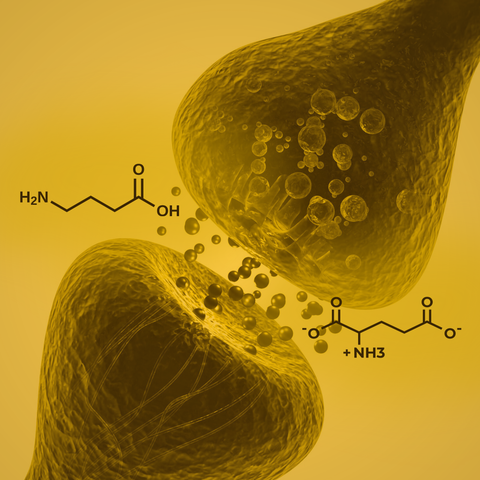
The human brain and central nervous system (CNS) are notoriously complex, operating through a huge network of neurons that communicate with each other using chemical messengers, or neurotransmitters. Although several neurotransmitters enable the brain to function properly, GABA (gamma-aminobutyric acid) and glutamate are two of the most indispensable [1,2].
They play a fundamental role in regulating excitatory and inhibitory signaling and shape the delicate balance needed for normal brain activity. It’s therefore important to understand the differences in function between these two neurotransmitters and how they relate to brain homeostasis, as well as how imbalances may contribute to neurological disorders.
In today’s article, we explore GABA and glutamate, touch on the molecular mechanisms underpinning their actions, and their contributions to various physiological and pathological processes.
GABA, Glutamate, and the Basics of Neurotransmission
The foremost distinction between GABA and glutamate is their opposing functions in the CNS. GABA is the brain’s main “inhibitory transmitter” whereas glutamate (between glutamate and glutamine, glutamine is the precursor) is the primary “excitatory neurotransmitter” [3-5]. The balance between these two processes underpins brain function and is essential for proper neuronal communication.
GABA reduces neuronal excitability in the adult brain by binding to GABA receptors on postsynaptic neurons [6]. When GABA is released from a presynaptic neuron and binds to its corresponding receptor, it causes an influx of chloride ions into the neuron or an efflux of potassium ions. These shifts effectively hyperpolarize the neuron, making it less likely to fire an action potential and thus “putting the brakes” on the brain, protecting it against seizures, anxiety, and excitotoxicity. GABA therefore helps to regulate mood, motor control, and cognition.
On the other hand, glutamate is the brain’s foremost excitatory neurotransmitter in that it promotes the firing of neurons [7]. When glutamate binds to its corresponding receptors (mainly NMDA, AMPA, and kainate receptors), sodium and calcium ions enter the postsynaptic neuron causing depolarization and therefore increasing the likelihood of an action potential, thus “pressing the accelerator” on the brain [8,9].
Glutamate’s excitatory role is essential to learning, memory formation, and synaptic plasticity. Through its involvement in long-term potentiation (LTP), glutamate contributes to the strengthening of synaptic connections, which underpins vital cognitive functions such as learning and memory recall [10].
The Interplay Between GABA and Glutamate
The balance between GABA and glutamate signaling ensures that the brain can function optimally, by adjusting neuronal activity as needed for many different tasks.
As the chief inhibitory neurotransmitter, GABA is involved in a wide range of functions. For example, GABAergic signaling is at the core of anxiety regulation [11]. Medications like benzodiazepines work by augmenting the effects of GABA at GABA-A receptors, bringing about reduced anxiety and a more sedated state [12,13]. GABAergic inhibition in the basal ganglia is key to regulating movement. Impairments in GABA signaling are associated with movement disorders such as Huntington's disease, dystonia, and Parkinson’s disease. GABA also plays a significant role in the regulation of sleep, which is necessary for restoration of the body.
Glutamate is indispensable for processes related to cognition and neural plasticity. These include learning and memory and support the mechanisms underpinning neuroplasticity (the ability of the brain to reorganize itself by forming new neural connections) [8,10]. Glutamate also excites neurons in pathways related to motor control and sensory perception, facilitating the communication needed for movement and sensation.
Given their opposing roles, dysregulation of GABA and glutamate levels can lead to a broad range of neurological disorders. A deficiency in GABAergic signaling or reduced GABA levels can result in excessive excitatory activity, which is a feature of conditions such as epilepsy [14], anxiety disorders, and insomnia [15]. Conversely, excessive glutamatergic activity or increased glutamate levels can be equally detrimental, contributing to excitotoxicity, a condition whereby overactivation of glutamate receptors leads to neuronal injury or death.
Dysregulated glutamate system signaling is involved in the progression of neurodegenerative conditions such as Alzheimer’s disease [16] and amyotrophic lateral sclerosis (ALS) [17]. During a stroke, excessive glutamate release can occur, which leads to excitotoxicity and the death of neurons.
Therapies Targeting GABA and Glutamate
As discussed above, the critical roles of GABA and glutamate in many facets of brain function have led to their targeting of therapeutic interventions in a variety of neurological and psychiatric conditions.
Drugs that target and enhance GABAergic activity include benzodiazepines for the treatment of anxiety, insomnia, and epilepsy; barbiturates for seizure management [18] (although less so these days due to the risk of dependence), and gabapentin for neuropathic pain, anxiety, and epilepsy.
Conversely, drugs that modulate glutamatergic activity and reduce excitatory signaling include NMDA receptor antagonists such as memantine (which has been used in Alzheimer’s disease) which can block excitotoxicity and have a neuroprotective effect [19,20]. Drugs of this kind (i.e., N-acetylcysteine, acamprosate, modafinil) can also be leveraged for the treatment of drug and behavioral addictions [21].
Summary
In this article, we have discussed how GABA and glutamate are central to the regulation of the activity of neurons and brain networks, and how the interplay between them maintains the brain’s balance (excitation vs. inhibition). While GABA is the primary inhibitory transmitter (the brake), calming neural circuits, glutamate is the accelerator that drives excitatory signals underlying cognition, learning, and memory. When the delicate balance between the two neurotransmitters is compromised, neurological conditions can arise such as anxiety, epilepsy, and neurodegenerative diseases. Understanding the interplay between these pathways might help researchers and clinicians develop more effective treatments for such conditions and improve brain health and function in the long run.
If you're looking for effective ways to naturally increase GABA in our brain, you might want to consider two superb options that have been carefully calibrated by the 4 physicians at Troscriptions — Tro Zzz and Tro Calm.
Both of these products contain ingredients that modulate the GABA system and work synergistically and safely without risk of dependence or tolerance when used as directed. But remember, these are not magical quick fixes. They are effective tools that can help you now along your path to optimal health.
References
[1] O.A.C. Petroff, GABA and glutamate in the human brain, Neuroscientist 8 (2002) 562–573. https://doi.org/10.1177/1073858402238515.
[2] S.M. Sears, S.J. Hewett, Influence of glutamate and GABA transport on brain excitatory/inhibitory balance, Exp Biol Med (Maywood) 246 (2021) 1069–1083. https://doi.org/10.1177/1535370221989263.
[3] D.A. McCormick, GABA as an inhibitory neurotransmitter in human cerebral cortex, J Neurophysiol 62 (1989) 1018–1027. https://doi.org/10.1152/jn.1989.62.5.1018.
[4] M.M. Pal, Glutamate: The Master Neurotransmitter and Its Implications in Chronic Stress and Mood Disorders, Front Hum Neurosci 15 (2021) 722323. https://doi.org/10.3389/fnhum.2021.722323.
[5] B.S. Meldrum, Glutamate as a Neurotransmitter in the Brain: Review of Physiology and Pathology, The Journal of Nutrition 130 (2000) 1007S-1015S. https://doi.org/10.1093/jn/130.4.1007S.
[6] A. Ahtiainen, B. Genocchi, N.P. Subramaniyam, J.M.A. Tanskanen, T. Rantamäki, J.A.K. Hyttinen, Astrocytes facilitate gabazine-evoked electrophysiological hyperactivity and distinct biochemical responses in mature neuronal cultures, J Neurochem 168 (2024) 3076–3094. https://doi.org/10.1111/jnc.16182.
[7] S.R. Platt, The role of glutamate in central nervous system health and disease--a review, Vet J 173 (2007) 278–286. https://doi.org/10.1016/j.tvjl.2005.11.007.
[8] A. Gasiorowska, M. Wydrych, P. Drapich, M. Zadrozny, M. Steczkowska, W. Niewiadomski, G. Niewiadomska, The Biology and Pathobiology of Glutamatergic, Cholinergic, and Dopaminergic Signaling in the Aging Brain, Front. Aging Neurosci. 13 (2021) 654931. https://doi.org/10.3389/fnagi.2021.654931.
[9] S.F. Traynelis, L.P. Wollmuth, C.J. McBain, F.S. Menniti, K.M. Vance, K.K. Ogden, K.B. Hansen, H. Yuan, S.J. Myers, R. Dingledine, Glutamate receptor ion channels: structure, regulation, and function, Pharmacol Rev 62 (2010) 405–496. https://doi.org/10.1124/pr.109.002451.
[10] G. Riedel, Glutamate receptor function in learning and memory, Behavioural Brain Research 140 (2003) 1–47. https://doi.org/10.1016/S0166-4328(02)00272-3.
[11] A.V. Kalueff, D.J. Nutt, Role of GABA in anxiety and depression, Depress. Anxiety 24 (2007) 495–517. https://doi.org/10.1002/da.20262.
[12] R.J. Walters, S.H. Hadley, K.D.W. Morris, J. Amin, Benzodiazepines act on GABAA receptors via two distinct and separable mechanisms, Nat Neurosci 3 (2000) 1274–1281. https://doi.org/10.1038/81800.
[13] R.W. Olsen, W. Sieghart, International Union of Pharmacology. LXX. Subtypes of gamma-aminobutyric acid(A) receptors: classification on the basis of subunit composition, pharmacology, and function. Update, Pharmacol Rev 60 (2008) 243–260. https://doi.org/10.1124/pr.108.00505.
[14] D.M. Treiman, GABAergic Mechanisms in Epilepsy, Epilepsia 42 (2001) 8–12. https://doi.org/10.1046/j.1528-1157.2001.042suppl.3008.x.
[15] D.T. Plante, J.E. Jensen, J.W. Winkelman, The role of GABA in primary insomnia, Sleep 35 (2012) 741–742. https://doi.org/10.5665/sleep.1854.
[16] M.R. Hynd, H.L. Scott, P.R. Dodd, Glutamate-mediated excitotoxicity and neurodegeneration in Alzheimer’s disease, Neurochem Int 45 (2004) 583–595. https://doi.org/10.1016/j.neuint.2004.03.007.
[17] E. Foran, D. Trotti, Glutamate transporters and the excitotoxic path to motor neuron degeneration in amyotrophic lateral sclerosis, Antioxid Redox Signal 11 (2009) 1587–1602. https://doi.org/10.1089/ars.2009.2444.
[18] P.A. Saunders, I.K. Ho, Barbiturates and the GABAA receptor complex, Prog Drug Res 34 (1990) 261–286. https://doi.org/10.1007/978-3-0348-7128-0_7.
[19] A.O. Egunlusi, J. Joubert, NMDA Receptor Antagonists: Emerging Insights into Molecular Mechanisms and Clinical Applications in Neurological Disorders, Pharmaceuticals 17 (2024) 639. https://doi.org/10.3390/ph17050639.
[20] R. Wang, P.H. Reddy, Role of Glutamate and NMDA Receptors in Alzheimer’s Disease, J Alzheimers Dis 57 (2017) 1041–1048. https://doi.org/10.3233/JAD-160763.
[21] M.F. Olive, R.M. Cleva, P.W. Kalivas, R.J. Malcolm, Glutamatergic medications for the treatment of drug and behavioral addictions, Pharmacology Biochemistry and Behavior 100 (2012) 801–810. https://doi.org/10.1016/j.pbb.2011.04.015.





Comments (0)
There are no comments for this article. Be the first one to leave a message!